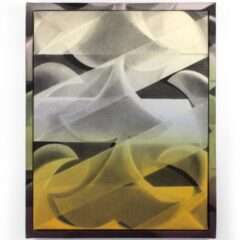We went to DCCA March 24 for the 2012 Gretchen Hupfel Symposium’s Saturday panels. The topics covered building, cities, and objects, recycling, making versus appropriating — all topics that are hot in the art world these days. Sadly, we missed Marshall Brown‘s apparently memorable keynote talk Friday night. But the architect made some sparky comments during the panel sessions that gave us a glimpse of his broad understanding of the topics at hand.
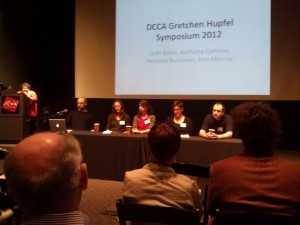
Art historian and freelance curator Susan Isaacs chaired the panel on construction, with four artists–Leah Bailis and Anthony Cervino, featured in the show “Under Construction,” which the curator organized; and the other two, Erin Murray, who has a solo show at DCCA right now, and Amanda Burnham, who showed there previously.
Since much of the discussion was about architecture in the real world, it struck us that someone should have organized the architecture of the panels, which fell into the traditional Q and A structure, with the moderators, Isaacs and DCCA Curator of Contemporary Art Maiza Hixson, posing questions to all, with the microphone passed down the table so each panelist had a chance to answer. A less formal (less constructed, more free-flowing) approach might have been nicer. This traditional format is slow and it tends to bring on audience fatigue. As you wait for each panel member to get their turn, you begin to count the minutes.
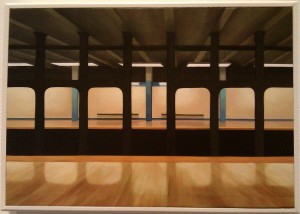
That’s a small complaint however. For what was said was pretty interesting. The artists on Isaac’s panel seem to be channeling ideas of humankind and human emotions in works that use tropes of building, housing, cities, all bereft of figures, where the human is implied but absent. Also interesting, a fair number of the artists were from (or had spent time in) Ohio, including Burnham, who is from Toledo; and Maiza Hixson (moderator of the second panel), who lived in Cincinnati.
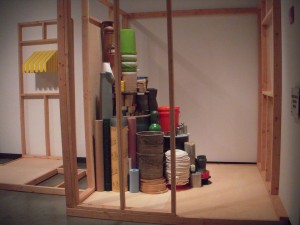
Cervino, who teaches at Dickinson College in Carlisle, PA, talked about how his piece in Under Construction used objects from a previous installation that had been cannibalized for this new piece.
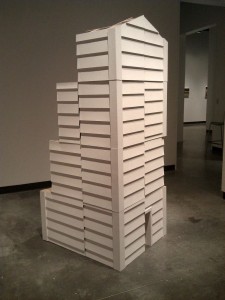
Bailis called her house fragments “a feminine take on macho fragmentation” (of the Gordon Matta Clark caliber). She mentioned that in her most recent work, she has gone back to her roots in film and is making works that are about gender and “the space in between.” Her comments engendered a discussion on gender and art and how fraught it was, given the historical dismissal of women’s work.
In answer to a question about how quiet the works in Under Construction are, Bailis said that her works are about isolation so they are by definition quiet. Burnham, whose works are not in Under Construction, makes rather noisy ink on cut paper works — Red Grooms-ian scenes of cities that spill off the wall and onto the floor and interact with viewers. She confessed she loves noisy spaces.
Murray, who confessed she grew up in an “idiosyncratic building that was a character in my life” (a cylindrical house designed by her self-taught-architect father) is all about psychological spaces and called her works “more portraits than landscapes.” She herself moved to the city where she sees a whole generation of people trying to create things like urban farming–inner-city utopias. Having grown up watching “the urban utopias of Sesame Street and Mr. Rogers’ neighborhood,” she moved from the “alienating suburbs” in search of that better life.

Marshall Brown, talking about architecture today said there are two camps, the makers and the thinkers. The makers are boys with toys (some are women). Their attitude is “I can do it myself on the computer and build it.” The other side says architecture is a mediated practice whose motto is “I make a model and someone else builds it.” He himself prefers to think, he said. Take out the materiality and you have to think.

The panel was so focused on the built environment we were surprised to see that the exhibit “Under Construction” had a much wider variety of work in it, some of it quite a lot of fun.
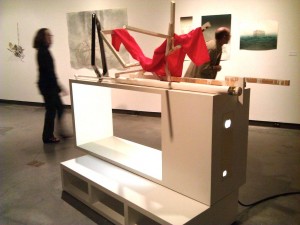
We loved the loopy anti-modernist tableaux of Michael Jones McKean; the Matthew Barney-esque Ron Longsdorf installation; the crazy (and perhaps 3-D printed?) building-jewelry by Joshua DeMonte; and the decorative wall ornament in cardboard and masking tape by Joe Netta.
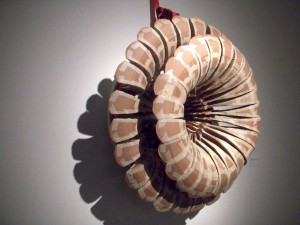
The second session, chaired by DCCA Curator of Contemporary Art, Maiza Hixson, dealt with the Dufala Brothers’ new work in one room of DCCA and with the show Contraption, organized by Hixson. Panelists included Billy and Steven Dufala, Tim Eads, C. Grant Cox III and Lauren Ruth.
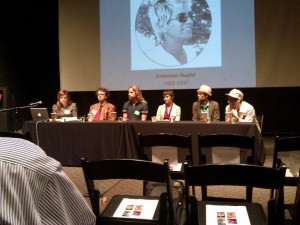
Hixson led off saying the works in the exhibit show a reaction to the industrial revolution, mass production, consumption, appliances and big box stores. There was a lot of talk about recycling and about the artists’ processes in general.

Steven Dufala said their new work, “HVAC shelter,” is not a critique but about housing, mass production and trash.
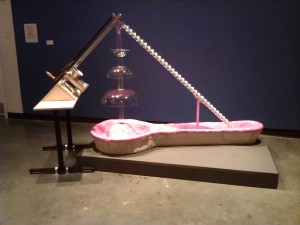
Ruth said her work was not recycling but repurposing. Her fountain piece is a reaction to digital technology, which often hides the mechanics. Her father is a physicist and she said she does a lot of her prep work on paper. Her fountain — based on a chocolate fountain with some Duchampian sexual innuendo thrown in — exposes the mechanical and invites interaction.
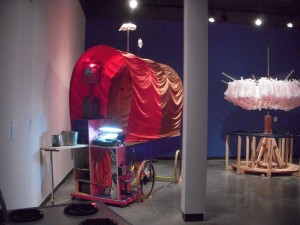
Eads seemed in agreement with Ruth about not liking digital technology. He grew up on a ranch where if the windmill was broken they had to fix it right then or the cattle would go thirsty. He said he had a problem with laser cutters and that kind of technological tool. He prefers to use store-bought materials and weld, cut, glue, nail and sew them together. Eads characterized his work as wacky and humorous. About recycling, Eads said don’t make a big deal of it — it’s been around since 1913 with Duchamp’s readymades.

Cox said he had a lot in common with Eads and that humor gave him validation. He is presenting the absurdity of things and we should feel free to embrace it. Cox seemed bemused when he confessed that he came from a family of hoarders and grew up stumbling over stuff. His wild kiddy bike on an even wilder treadmill shows a kind of jumble-sale genius.
Steven Dufala had the most trenchant comment. Artists are not living in dystopia. We are not in post-apocalyptic times. Artists may be making constructs of dystopia but at the end of the day you brush your teeth, eat and go to bed. The work is just a construct.
In a panel that had a surprisingly large amount of nuts and bolts talk about process, Billy Dufala contributed a wry comment about the downside of using recycled materials. When he buys materials, he gets to write off the materials costs in his taxes. “I usually write off thousands of dollars in materials.” But now, getting materials from the recycling center, he won’t be able to get that tax write off. It’s an IRS disincentive for recycling and upcycling.
Following up on that, Marshall Brown said that the waste stream from construction was drying up. Thirty percent of a construction budget is waste. The developers want that money, so they are tracking materials now to keep the waste down and their profit up.
As a perfect complement to this show, the Fischli and Weiss video “The Way Things Go” is playing in the DCCA lobby.


